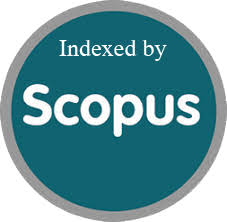Traffic Performance Assessment and Modeling Microscopic Characteristics on Urban Multilane Highways in Mosul City
Abstract
As the multilane highway system is a fundamental part of the urban highway network, it is essential for traffic engineers, planners, and policymakers to understand and evaluate the quality of service these facilities provide. The evaluation process was conducted using the US Highway Capacity Manual, employing Level of Service (LOS) concept. Additionally, traffic flow is significantly influenced by microscopic characteristics, making it crucial to model these characteristics for each highway lane. This modeling impacts both vehicular and driver behavior. This research aims to assess the (LOS) for five segments of multilane highways using (HCM) 2022 methodology. Additionally, modeling the relationships between speed, headway, and spacing. The results indicate a failure in the level of service in two of the studied segments, especially for projections seven years into the future. For speed-headway-spacing models, the coefficient of determination (R-square) and the chi-square test were used to evaluate the goodness of fit for the models, using SPSS. The findings showed no significant differences between the predicted and observed data, highlighting traffic characteristics of flow, speed, and density. These models can be utilized to identify various traffic parameters in future studies on the examined highways.
References
- . S. B., Estimation of Traffic Density To Compare Speed-Density Models With Moving Observer Data, Int. J. Res. Eng. Technol., vol. 04, no. 08, pp. 471474, 2015, doi: 10.15623/ijret.2015.0408080.
- A. Of, C. A. R. Following, H. Along, and M. Highway, Jurnal Teknologi ANALYSIS OF CAR FOLLOWING HEADWAY ALONG, vol. 4, pp. 5964, 2016.
- B. D. . GREENSHIELDS, T H E PHOTOGRAPHIC METHOD OF STUDYING T R A F F I C BEHAVIOR.
- B. S. (n.d.), EINFHRUNG Das Bushnell Schnellradarinstrument nutzt die Digitaltechnologie fr sofortige Geschwindigkeitsmessung. [Online]. Available: chrome-extension://efaidnbmnnnibpcajpcglclefindmkaj/https://www.armas.es/files/page/mod_ficheros/1/bushnell_medidor_velocity.pdf
- D. Khaled, K. Abdul, and K. Naji, Evaluation and Improvements of Congestion in Chosen Multilane Segments in Al-Hillah City, vol. 7, no. 1, pp. 64446451, 2022.
- D. Kong and X. Guo, Analysis of vehicle headway distribution on multi-lane freeway considering car-truck interaction, Adv. Mech. Eng., vol. 8, no. 4, pp. 112, 2016, doi: 10.1177/1687814016646673.
- D. ROY, S. CHAKRABORTY, S. KUMAR, and S. CHATTERJEE, Lane Density as Measure of Effectiveness of Multi lane Indian Highways under Heterogeneous Traffic Conditions Traffic Engineering, no. 1968, pp. 3135, 2016, doi: 10.15224/978-1-63248-114-6-18.
- F. T. Creasey and B. Schroeder, HIGHWAY CAPACITY M ANUAL, 7th ed. washington, DC: transportation research board, 2022.
- Farman Majeed Salam and A. prof. D. H. M. Majid, Evaluation of Capacity and Level of Service for Heterogeneous Traffic of Urban Multi-Lane Highways, Construction, vol. 2, no. 2, pp. 3138, 2022, doi: 10.15282/construction.v2i2.8609.
- G. J. Qasim, A. K. Jameel, A. M. Abdulwahab, and A. S. Rajaa, Estimating a congested road capacity-Headway relationship of a multi-lane highway in an urban area based on lane position, Period. Eng. Nat. Sci., vol. 8, no. 3, pp. 12631279, 2020, doi: 10.21533/pen.v8i3.1449.g611.
- H. A. Awad and H. A. Mohammed, Evaluating Traffic Operation for Multilane Highway (Ramadi Fallujah) Highway as Case Study, Iraqi J. Civ. Eng., vol. 9, no. 1, pp. 120134, 2013, doi: 10.37650/ijce.2013.80394.
- H. Faheem and I. H. Hashim, Analysis of Traffic Characteristics at Multi-lane Divided Highways, Case Study from Cairo-Aswan Agriculture Highway, Int. Ref. J. Eng. Sci.,vol. 3, no. 1, pp. 5865, 2014, [Online]. Available: www.irjes.com58%7C
- Institute of Transportation Engineers, Traffic Calming- Traffic Engineering Handbook. pp. 531583, 2009.
- L. Li and X. (Michael) Chen, Vehicle headway modeling and its inferences in macroscopic/microscopic traffic flow theory: A survey, Transp. Res. Part C Emerg. Technol., vol. 76, pp. 170188, 2017, doi: 10.1016/j.trc.2017.01.007.
- L. V. Leong, T. A. Azai, W. C. Goh, and S. A. M. Shafie, Development and assessment of free-flow speed models based on different methods of measurements for inter urban multilane highways in Malaysia, J. Appl. Eng. Sci., vol. 17, no. 3, pp. 256263, 2019, doi: 10.5937/jaes17-21205.
- M. Fellendorf and P. Vortisch, Validation of the Microscopic Traffic Flow Model VISSIM in Different Real-World Situations, Transp. Res. Board 80th Annu. Meet., no. January 2001, pp. 19, 2001, [Online]. Available: http://trid.trb.org/view.aspx?id=689890
- M. Msallam, Evaluation and Improvement of the Level of Service of Multi-Lane Highways in Jordan, Elektriniki asopis graevinskog Fak. Osijek, no. 18, pp. 7181, 2019, doi: 10.13167/2019.18.7.
- N. Jayaratne, C. Rathnayake, and H. Pasindu, Evaluating the speed-flow relationship of urban four-lane roads under heterogeneous traffic conditions, MERCon 2018 - 4th Int. Multidiscip. Moratuwa Eng. Res. Conf., pp. 455459, 2018, doi: 10.1109/MERCon.2018.8421996.
- R. A. Giancristofaro and L. Salmaso, Model performance analysis and model validation in logistic regression, Statistica, vol. 63, no. 2, pp. 375396, 2003.
- S. Li, K. Zhu, B. H. W. Van Gelder, J. Nagle, and C. Tuttle, Reconsideration of sample size requirements for field traffic data collection with global positioning system devices, Transp. Res. Rec., no. 1804, pp. 1722, 2002, doi: 10.3141/1804-03.
- S. M. Ross, Introduction to Probability and Statistics for Engineers and Scientists, Fifth Edition. 2014. doi: 10.1016/C2013-0-19397-X.
- S. Salini, S. George, and R. Ashalatha, Effect of Side Frictions on Traffic Characteristics of Urban Arterials, Transp. Res. Procedia, vol. 17, no. December 2014, pp. 636643, 2016, doi: 10.1016/j.trpro.2016.11.118.
- S. Spraggs, Traffic engineering, vol. 18, no. 3. 2000. doi: 10.1023/A:1026701215511.
- S. V. Velmurugan, E. Madhu, K. Ravinder, K. Sitaramanjaneyulu, and S. Gangopadhyay, Critical Evaluation of Roadway Capacity of Multi-Lane Conditions Through Traditional and Microscopic Simulation Models, J. Indian Roads Congr., no. 566, pp. 235264, 2010.
- S. Wijayaratna, Impacts of on-street parking on road capacity, ATRF 2015 - Australas. Transp. Res. Forum 2015, Proc., no. October, pp. 115, 2015.
- T. Ghosh, S. K. Roy, and S. Gangopadhyay, Capacity Estimation of Multilane Highways under Heterogeneous Traffic Conditions using Micro-Simulation Technique, SAMRIDDHI A J. Phys. Sci. Eng. Technol., vol. 12, no. 01, pp. 2025, 2020, doi: 10.18090/samriddhi.v12i01.4.
- T. R. B. N. R. Council, Highway Capacity Manual. 1984. [Online]. Available: https://www.semanticscholar.org/paper/731c38992b8dcad62b1aa5e2f807fd0ceaa12b77
- T. Tsuboi and N. Yoshikawa, Traffic flow analysis in Ahmedabad (India), Case Stud. Transp. Policy, vol. 8, no. 1, pp. 215228, 2020, doi: 10.1016/j.cstp.2019.06.001.
- Transportation Research Board National Research Council, Highway Capacity Manual, no. May 2001. 2000.
- X. Chen, L. Li, and Y. Zhang, A markov model for headway/spacing distribution of road traffic, IEEE Trans. Intell. Transp. Syst., vol. 11, no. 4, pp. 773785, 2010, doi: 10.1109/TITS.2010.2050141.








